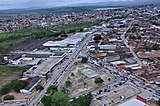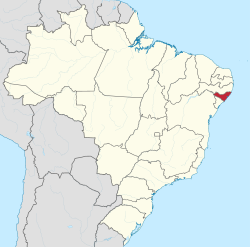Alagoas
| Alagoas | |||
|---|---|---|---|
| Symbols | |||
|
|||
| Basic data | |||
| Country | Brazil | ||
| Capital | Maceió | ||
| surface | 27,843.3 km² | ||
| Residents | 3,337,357 (2019 estimate) | ||
| density | 120 inhabitants per km² | ||
| ISO 3166-2 | BR-AL | ||
| Website | www.governo.al.gov.br | ||
| politics | |||
| governor | Renan Filho | ||
| Political party | MDB | ||
| economy | |||
| GDP | 49,456 million R $ 14,819 R $ per capita (2016) |
||
Coordinates: 9 ° 40 ′ S , 36 ° 42 ′ W
Alagoas (portug. A [s] lagoas , the lakes , named after two distinctive inland lakes) with the capital Maceió is a federal state in the northeast region of Brazil . As of July 1, 2019, the population was estimated at 3,337,357. With an area of around 27,843.3 km² (2018), it is 25th of the 27 federal units.
geography
Alagoas borders the Brazilian states of Pernambuco , Sergipe and Bahia and the Atlantic Ocean. It is the second smallest state in Brazil in terms of area, only Sergipe is smaller. The smallest unit is the federal district .
Alagoas has 230 kilometers of coastline with white sandy beaches. 65 kilometers of them are in the catchment area of the capital Maceió. Along the Rio São Francisco (nickname "o Velho Chico", "old boy"), which forms the border with the states of Sergipe and Bahia, there are some historic colonial cities.
history
At the beginning of the 16th century, the French occupied the area, after their expulsion by the Portuguese in 1535, Alagoas, which belonged to the Pernambuco captaincy until 1817 , was occupied by the Dutch West India Company from 1630 to 1654 . The Portuguese had to retreat to the often swampy hinterland. From there they made repeated advances until the Dutch finally left the country. The attempt of a Dutch-Brazil failed and was never taken up again.
Until 1817 and the revolt of Pernambuco (Revolução Pernambucana), the history of Alagoas was to be equated with that of Pernambuco. The suppression of the independence movement had on September 16, 1817 the result of the separation of the area from Pernambuco as "capitania independente" Kapitanat Alagoas , the first own governor was Sebastião Francisco de Melo e Póvoas . This captaincy lasted in the time of King John VI. until 1821. Then the captains were converted into provinces and incorporated into the constitution under Emperor Peter I.
During the empire, the separatist and republican movement of the Equatorial Federation of 1824 received the support of prominent figures from Alagoas. In 1834 the province of Alagoas received its own parliament. When the republic was founded in 1889, the state of Estado de Alagoas was also founded, with Aureliano Augusto de Azevedo Pedra , Manuel Ribeiro Barretos de Meneses and Ricardo Brenand Monteiro forming the first provisional government . The following governors were appointed by the federal government, the first elected president was Euclides Vieira Malta from 1900 to 1903.
politics
Governor since the elections in Brazil in 2018 Renan Filho of the Movimento Democrático Brasileiro (MDB), lieutenant governor since 2015 Luciano Barbosa the same party. The official seat of the government has been the Palácio República dos Palmares in Maceió since 2006 .
Renan Filho , Governor, since January 1, 2019
Palácio República dos Palmares , seat of government
Alagoas sends nine federal representatives to the Chamber of Deputies and three senators to the federal senate of the Brazilian National Congress .
economy
Most of the residents of Alagoa live from tourism and sugar cane cultivation , another employer is the public administration. Alagoas is the second largest producer of sugar and ethanol in Brazil. About half of the country's area is covered by sugar cane plantations, the rest of the agricultural area is used for cattle and poultry breeding as well as for growing pineapples, bananas, cotton, corn, coconut and rice. There are tobacco plantations around the city of Arapiraca. Inshore fishing is carried out.
The industry produces food, cement and textiles, extracts iron ore, mineral salts, crude oil and gas as well as marble and granite .
population
Population development from 1872
Source: IBGE, 2019 is an estimate.

Ethnic composition
Ethnic groups according to the statistical classification of the IBGE (as of 2000 with 2,827,856 inhabitants, as of 2010 with 3,120,494 inhabitants): Of these, 2,207,809 (73.64%) residents lived in urban areas and 822,685 (26.36%) ) in rural areas.
| group | Share 2000 |
Share 2010 |
annotation |
|---|---|---|---|
| Brancos | 964,919 (34.12%) | 968,288 (31.03% ) | Whites, descendants of Europeans |
| Pardos | 1,681,391 (59.46%) | 1,897,214 (60.80% ) | Mixed races, mulattos , mestizos |
| Pretus | 142,747 (5.05%) | 206,030 (6.60% ) | black |
| Amarelos | 2,950 (0.10%) | 35,183 (1.13% ) | Asians |
| Indigenous people | 9,074 (0.32%) | 13,773 (0.44% ) | indigenous population |
| without specification | 26,775 | 7th |
Most populous cities
| No. | Munizip | Population estimate 2017 |
image |
|---|---|---|---|
| 1 | Maceió | 1,029,129 |
 Maceió Arapiraca Maragogi   |
| 2 | Arapiraca | 234.185 | |
| 3 | Rio Largo | 76.019 | |
| 4th | Palmeira dos Indios | 74.208 | |
| 5 | União dos Palmares | 66,477 | |
| 6th | Penedo | 64,497 | |
| 7th | Sao Miguel dos Campos | 61,827 | |
| 8th | Campo Alegre | 57,548 | |
| 9 | Coruripe | 57,498 | |
| 10 | Delmiro Gouveia | 52 597 | |
| 11 | Marechal Deodoro | 52,260 | |
| 12 | Santana do Ipanema | 48,232 | |
| 13 | Atalaia | 47,744 | |
| 14th | Teotônio Vilela | 44,666 | |
| 15th | Girau do Ponciano | 41,279 | |
| 16 | Pilar | 35,552 | |
| 17th | São Luís do Quitunde | 34,961 | |
| 18th | São Sebastião | 34,551 | |
| 19th | Maragogi | 32,940 | |
| 20th | São José da Tapera | 32,626 |
Judiciary
Alagoas is the Brazilian state with the highest murder rate. In 2010 a total of 2,226 people were violently killed, which corresponds to a rate of 71.3 murders per 100,000 inhabitants. The figure does not include robberies resulting in death.
religion
The state of Alagoas comprises three dioceses of the Roman Catholic Church: The Archdiocese of Maceió , the Diocese of Palmeira dos Índios and the Diocese of Penedo , about three quarters of the inhabitants of Alagoas are Roman Catholic. There are numerous Protestant churches, around 20 percent of the residents of Alagoas belong to them. In Alagoas there is a synagogue (in Maceió) and no mosque.
Personalities
- Zumbi was born in Palmares in 1655. Zumbi was one of the most famous representatives of the black resistance against slavery in Brazil and since 1670 leader of the largest Quilombo of Brazil (refugee camp for fled slaves), Quilombo dos Palmares with over 30,000 inhabitants. The Quilombo was in the Serra da Bariga region, which belongs to the city of União dos Palmares. It was founded around 1600 and only destroyed in 1694. Zumbi was denounced on November 20, 1695 by former comrades-in-arms, captured and beheaded at the age of 40. Zumbi dos Palmares is the namesake of the international airport in Maceió.
- Manuel Deodoro da Fonseca , born on August 5, 1827 in Cidade de Alagoas, the first capital of the province of Alagoas, proclaimed the republic as Marshal on November 15, 1889 and was its first president. In 1939, the town of his birth was renamed Marechal Deodoro.
- Floriano Peixoto , born on April 30, 1839 in Maceió, Ipioca district, was Vice President under Marechal Deodoro da Fonseca and, after his resignation, second President of the Republic.
- Aurélio Buarque de Holanda Ferreira , born on May 3, 1910 in Passo de Camaragipe, died on February 28, 1989 in Rio de Janeiro, was a literary critic, lexicographer, linguist, teacher, translator and essayist. His best known work is the Novo Dicionário da Língua Portuguesa (New Dictionary of the Portuguese Language), simply referred to as "The Aurélio" in the Portuguese-speaking world. In the old governor's palace in Maceió, which has also been used as a museum since 2005, there is a permanent exhibition about his life and work.
- Lêdo Ivo , born on February 18, 1924 in Maceió, died on January 20, 2013 in Seville, Spain, was a journalist, poet, cronist, essayist and novelist who has received many awards in Brazil and abroad. On November 13, 1986, he was accepted into the Academia Brasileira de Letras (Rio de Janeiro), the largest award for a writer in Brazil. There is also a permanent exhibition about his life and work in the old governor's palace in Maceió.
- Graciliano Ramos de Oliveira , born on October 27, 1892 in Quebrangulo, died on March 20, 1953 in Rio de Janeiro, was a writer and poet. For his work Vidas Secas (Karges Leben, Suhrkamp Verlag KG, 1992, ISBN 3-518-37167-3 ) he received the William Faulkner Foundation Prize in 1962. It was filmed in Brazil in 1963.
- Djavan , born on January 27, 1949 in Maceió, singer and Grammy winner.
- Mário Zagallo , born on August 9, 1931 in Maceió, was the first footballer to win the World Cup both as a player (1958, 1962) and as a coach (1970).
- Marta Vieira da Silva , in the February 19, 1986 Dois Riachos born, was approved by the FIFA six times for the FIFA Player of the Year chosen.
Web links
- Governo do Estado de Alagoas website (Portuguese)
- Legislative Assembly website , Assembleia Legislativa (Portuguese)
- Alagoas em Dados e Informações. In: dados.al.gov.br. Secretaria de Estado do Planejamento, Gestão e Patrimônio - Seplag / AL(comprehensive data portal).
Individual evidence
- ↑ a b c IBGE: Alagoas - panorama. Retrieved September 1, 2019 (Brazilian Portuguese).
- ↑ Helena Maria Mattos Pontes: Contas Regionais 2016: entre as 27 unidades da federação, somente Roraima teve crescimento do PIB. In: gov.br. IBGE - Agência de Notícias, accessed September 3, 2019 (Brazilian Portuguese).
- ↑ Luciano Barbosa 15 (MDB) Vice-governador - Alagoas - Eleições 2018. In: com.br. Retrieved July 6, 2020 (Brazilian Portuguese).
- ↑ IBGE Censo 2010 - Tabela 1.4 - População nos Censos Demográficos, segundo as Grandes Regiões e as Unidades da Federação - 1872/2010. In: censo2010.ibge.gov.br. Retrieved September 3, 2019 (Brazilian Portuguese).
- ↑ IBGE : Sistema IBGE de Recuperação Automática - SIDRA: Tabela 2093. Accessed on July 13, 2020 (Portuguese, database query, search terms Alagoas and Cor ou raça).
- ↑ Estimativas da população residente no Brasil e unidades da federação com data de referência em 1 ° de julho de 2017. (PDF; 2.7 MB) In: ibge.gov.br. Instituto Brasileiro de Geografia e Estatística (IBGE), 2017, accessed March 28, 2018 (Brazilian Portuguese).
- ↑ Alagoas registra em 2010 maior taxa de homicídio da história de um Estado accessed October 7, 2011 (pt)







